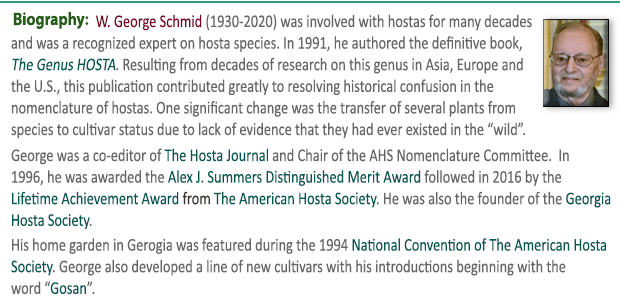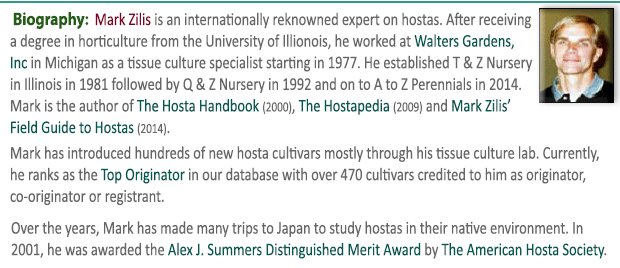|
  This species is native to
Japan
was collected by Kitamura and is considered a relative of
H. longipes. The plant
grows to a medium size about 12 inches in height by 16 inches wide as a mature
clump. It has rippled margins on the leaves which have a long,
narrow tip. The leaf petioles have reddish purple dots and the
leaves come to a distinct tip. Funnel-shaped, pale purple flowers with subtended whitish bracts bloom
in September to October (about 2 or 3 weeks after H. longipes). The flowers have purple anthers which
is a distinguishing trait. This species is native to
Japan
was collected by Kitamura and is considered a relative of
H. longipes. The plant
grows to a medium size about 12 inches in height by 16 inches wide as a mature
clump. It has rippled margins on the leaves which have a long,
narrow tip. The leaf petioles have reddish purple dots and the
leaves come to a distinct tip. Funnel-shaped, pale purple flowers with subtended whitish bracts bloom
in September to October (about 2 or 3 weeks after H. longipes). The flowers have purple anthers which
is a distinguishing trait.
 At one time, this was known as a
botanical variety (i.e. found in the wild) of
H. longipes but
The Genus Hosta by W. George Schmid (1991) designated it as being a full species. He says that its
Japanese name means "hosta of the equinox" i.e. flower buds are set
about the time when the day and night are of equal length. This
species was first collected from the
wilds of Honshu Island of
Japan in 1941 from rocky ledges and outcroppings. At one time, this was known as a
botanical variety (i.e. found in the wild) of
H. longipes but
The Genus Hosta by W. George Schmid (1991) designated it as being a full species. He says that its
Japanese name means "hosta of the equinox" i.e. flower buds are set
about the time when the day and night are of equal length. This
species was first collected from the
wilds of Honshu Island of
Japan in 1941 from rocky ledges and outcroppings.
According to
The Hostapedia by Mark Zilis (2009), "...useful in a breeding program
for its flowering habits and smooth green foliage. The whitish
bracts also have ornamental value."

 An article by
Hajime Sugata of Japan in
The
Hosta Journal (1994 Vol. 25 No. 2) states that "H.
aequinoctiantha grows only at the Yoro Mountains
in Gifu Pref. It is found abundantly around rocks of
Yoro Waterfall, a sightseeing place noted in
Japanese folklore. The natural habitat of H.
aequinoctiiantha is restricted to a small area;
its flowering period varies. An article by
Hajime Sugata of Japan in
The
Hosta Journal (1994 Vol. 25 No. 2) states that "H.
aequinoctiantha grows only at the Yoro Mountains
in Gifu Pref. It is found abundantly around rocks of
Yoro Waterfall, a sightseeing place noted in
Japanese folklore. The natural habitat of H.
aequinoctiiantha is restricted to a small area;
its flowering period varies.
The intermediate
species between H. longipes and H. aequinoctiiantha is
found on rocks near streams in the deep Midori
Valley, Neo Village, Motosu County. The flowers are
beautiful deep purple."
Mikiko Lockwood in an article on The Hosta Library titled,
A Little About Japanese Hosta Terms defines the term midori as green.


 |



